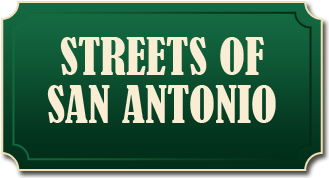StreetsOfSanAntonio.com
Streets of San Antonio
The Streets of San Antonio is a website based on the book, with the same name, about the history of San Antonio. It is based on extensive research of nineteenth century immigrants and the street names that honor their contribution to the city. The book investigates the history of San Antonio and the numerous families and communities that have contributed to the city and made it into what it is today.
|
Chapter Excerpts
Basse Road - Chapter Excerpt from Streets of San Antonio
Basse Road, located a few miles north of downtown, originates at West Avenue; continuing, it crosses Blanco Road, San Pedro Avenue, McCullough Avenue, and I-37 and ends at its intersection with Nacogdoches Road.
Stephan Heinrich (Henry) Basse (1804-1886), his wife Charlotte, and their five children, emigrated from Germany about 1850. Upon arriving in Texas, the family settled in Fredericksburg. Unlike many immigrant families who made their livelihood as farmers and ranchers upon their arrival in Texas, most of the Basse men and their families, according to census records, were involved in mercantilism. Henry Basse was a successful store merchant in Fredericksburg; his son Oscar served as a clerk in the store and later operated a sewing machine company.
See the StreetsofSanAntonio.com/BasseRoad page to read more.
Stinson - Chapter Excerpt from Streets of San Antonio
Stinson Airport is located south of downtown San Antonio near the intersection of Roosevelt Avenue and South Flores Street. Although no road in San Antonio bears the Stinson name, the name is important in that the field was the first municipal airport in San Antonio; it dates back to 1915.
Katherine Stinson (1891-1977), at the age of 21, was the fourth woman in the United States to receive her pilot's license. Soon after completing school, Stinson decided to study music abroad, but she had little money to pursue this dream. While looking for ways to raise money to attend school in Europe, she learned that stunt pilots could make as much as $1,000 per day at exhibits. Although weighing barely 100 pounds, this woman of slightly over five feet tall convinced her parents she was capable of flying. Looking for an instructor, she met Chicagoan Max Lillie, one of the first 25 people to receive a United States pilot‘s license and the first to receive the Expert Aviator‘s Certificate. Stinson asked him to teach her to fly. At first, he adamantly refused; however, Stinson insisted until he agreed. After only four hours of lessons, she was flying the plane solo. She spent the next several years, not studying music like she initially planned, but traveling around the United States on the exhibition circuit where she was nicknamed the "Flying Schoolgirl". Stinson also performed overseas, appearing in 32 aviation shows in China (including a private showing for Chinese leaders), Japan, Canada, and England. Stinson was the first woman to perform such feats as the loop-to-loop and the first person of either gender to perform skywriting at night.
See the StreetsofSanAntonio.com/Stinson page to read more.
Wetmore Road - Chapter Excerpt from Streets of San Antonio
Wetmore Road, located on the northside of San Antonio, extends northward from Loop 410 on the east side of San Antonio International Airport, crossing Bitters and Thousand Oaks roads. At the intersection of Thousand Oaks Road, the street changes name to Bulverde Road. At this junction are the remnants of what was known during the mid- to late-1800s as the Community of Wetmore.
Like many towns throughout Texas, San Antonio was significantly affected by the introduction of the railroad. Although most of the other cities in Texas, including Houston, Galveston, Austin, and Dallas, already had rail service, it was not until 1877 that the Greater Harrisburg and San Antonio (GH&SA) reached San Antonio. After the rail service's arrival, San Antonio's population almost doubled, and the number of farms in the city quadrupled. Following the success of the GH&SA, other rail companies began service to San Antonio. One of them, the International-Great Northern Railroad Company (I-GN), arrived in 1881. At the time, Jacob S. Wetmore, a director, worked for I-GN, and the depot was named for him.
See the StreetsofSanAntonio.com/WetmoreRoad page to read more.
|
About the Author
Eric Mapes is a University of Texas at San Antonio graduate and has done extensive history on the city of San Antonio.
ContactYou may use the contact form here. Additional InformationExternal Links |
|||||









